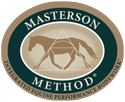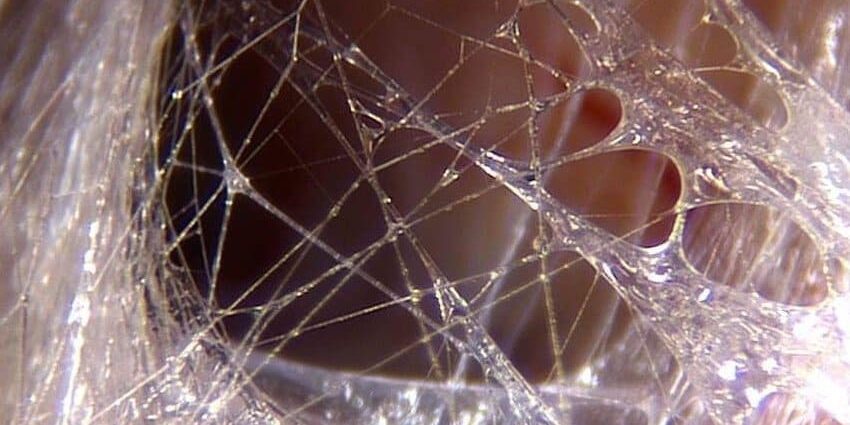By Leigh Jackson
In this article, Leigh Jackson, MMCP in the United Kingdom, shares her fascination with fascia. She gives us some scientific insights into this fascinating network of tissue. Leigh appreciates how we listen to the horse, create safety, and help them release tension throughout their bodies, addressing the entire fascial network.
Over twenty-five years ago I was introduced by an ‘holistic’ sports injury therapist and human Bowen practitioner to the concept of connective tissue within the body known as fascia. Through personal injury and her unravelling my body, I began a journey that took me from human to equine anatomy, bodywork and dissections of both species, and a fascination for the incredible and wonderful world of mammalian bodies.
When a horse (or a person) shows signs of a lesion (where there is tissue damage through injury or disease), we tend to focus directly on where these signs show, and address the pain and the symptoms, which is logical. But the body is interconnected and often, what causes that tension or lesion, may come from another part of the body. One of the main tissues that interconnect the body is fascia, the subject of this article.
One of the reasons why we haven’t recognized this interconnectedness of tissue is because, until recently, there was little access to equine dissections other than lower limbs and some internal organs.
What happens now that more equine dissections are available (see list of dissection courses below) is that our anatomical knowledge has extended and can be based on dissecting out the muscles, observing their origins and insertions, and thinking of them as a mechanical means of creating movement in the musculoskeletal system.
So now it is easier to isolate a group of muscles, tendons, and ligaments in a limb and think that the problem must be coming from there. For instance, an injury can, over time, become a restriction due to the horse compensating and result in a gait anomaly or lameness.
What does Fascia look like?
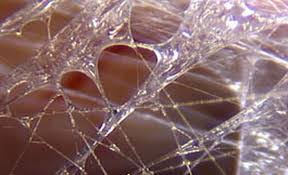 Fascia looks like a thin off-white opaque tissue and it is basically everywhere. It covers every muscle cell and fibre, surrounds, goes through, and holds every organ, blood vessel, bone, nerve fibre, and muscle in place. Fascia contains nerves that make it almost as sensitive as skin.
Fascia looks like a thin off-white opaque tissue and it is basically everywhere. It covers every muscle cell and fibre, surrounds, goes through, and holds every organ, blood vessel, bone, nerve fibre, and muscle in place. Fascia contains nerves that make it almost as sensitive as skin.
When stressed (physically or emotionally), fascia contracts and tightens up. It can be seen in open wounds and cuts of meat. Fascia gives the body structure and form; it creates a 3-D net of connective tissue. Fascial structures connect from top to toe, toe to top, head to tail, inside to outside, and side to side!
A fascial line is a connected line of tissue that if an injury occurs anywhere along its length, it will eventually affect the entire line in some way and it can take years to manifest as a problem unless it is addressed. All fascial lines connect to each other via fascia. No beginning and no end. Everything is connected.
Simply put – A healthy fascia provides a smooth surface that internal organs may slide / glide within the body cavities as it moves, and muscles etc. can lengthen, shorten, and glide along each other during motion.
Where is Fascia In The Body and What Is it Made Of?
There are a variety of types of fascia throughout the body:
- Superficial – found directly under the skin
- Deep – surrounds bones, muscles, nerves, and blood vessels
- Visceral – surrounds organs in cavities like the abdomen, lung (pleura, and heart (pericardium)
- Parietal – lines the wall of a body cavity (e.g., in the pelvis)
Collagen fibres are the main component in many fascial structures within the locomotion system. These fibers are the body’s most common protein, and it is predominant in the fascial web of the body. They are incredibly strong and can stand up to high tension forces and therefore are located where there are tension forces. They are there to protect and support the body.
How does Fascia function?
When stressed (physically or emotionally), fascia contracts and tightens up. It can be seen in open wounds and cuts of meat. Fascia gives the body structure and form; it creates a 3-D net of connective tissue. Fascial structures connect from top to toe, toe to top, head to tail, inside to outside, and side to side!
A fascial line is a connected line of tissue that if an injury occurs anywhere along its length, it will eventually affect the entire line in some way and it can take years to manifest as a problem unless it is addressed. All fascial lines connect to each other via fascia. No beginning and no end. Everything is connected.
Simply put – A healthy fascia provides a smooth surface that internal organs may slide / glide within the body cavities as it moves, and muscles etc. can lengthen, shorten, and glide along each other during motion.
How Do Stress, Strain, and Injury Impact Fascia?
Stress, malnutrition, infection, etc. may change the flexibility of fascia and thereby change the flexibility of the internal organs, blood vessels, and nerves that influence the exchange of nutrients and waste products. An animal living in a stressful environment where the fight or flight response of the sympathetic nervous system is dominant will, over time, show signs of ‘dis-ease’ if the dominance lasts for long periods. For instance, if the horse is experiencing chronic stress, it may influence dysfunction in the organs, such as the development of excess scar tissue in the liver, kidney, and lungs.
When an area of the body is under constant locomotion stress, a repetitive strain injury (RSI) can occur, and soft tissue becomes damaged over time. Repetitive and minute tears in muscle fibres that never have time to repair properly can turn into an RSI. This is why it’s important to both provide a varied exercise program (to prevent injury) and provide adequate time off after an injury before coming back into work.
A kick from another horse can cause bruising in the soft tissue and create swelling. Often months down the line, that area feels harder to the touch. A fall, slipping, skidding, or sliding will all take their toll on the muscular and fascial system. Often weeks, months or even years after an innocuous injury occurred, we suddenly have an issue in our horse’s performance (or even our own)! We have forgotten or dismissed the original cause. This is why a Masterson Method Certified Practitioner who’s working on your horse will ask, “Has your horse had any significant illnesses or falls/injuries that you’re aware of?”
How Can We Help Maintain Healthy Fascia?
Temperature, joints, and synovial fluid. Wintry weather increases the thickness of synovial joint fluid making joints feel stiff. It is therefore important to stress (especially in colder climates) the importance of taking time to warm up the joints and muscles, thereby avoiding strain, tearing, and injury. Summer heat and dehydration will also affect the fascia and its ability to glide and slide.
Regular Movement. Stabled horses do not get as much movement, typically, than horses with room to roam. They may require 20 minutes of warmup before the real work starts. A good rule for the stabled horse is ‘walk the first mile out and the last mile home.’ For turned out horses, you might consider the Paradise Paddock or Track System to help encourage your horse to move throughout the day.
Masterson Method Bodywork. Providing regular bodywork for your horse, no matter the season, will help maintain healthy fascia in your horse.
Jim Masterson, the founder of The Masterson Method, is so right when he talks about releasing tension in the front end, poll, TMJ, neck and shoulders. He says work in the front end will help release tension in the hind quarters, and vice versa. And one of the main reasons is the interconnections in the horse’s body through the myofascial lines.
You can use the tips below, or use this online directory to find a local Masterson Method Certified Practitioner near you.
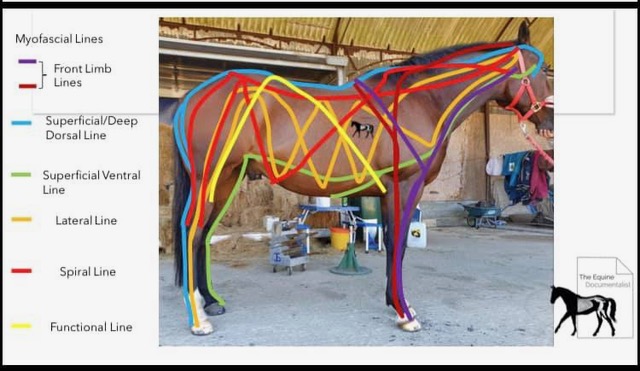
Myofascial Lines
The following four kinetic fascial lines are only four of 11 myofascial lines in the horse though and we really are just on the very tip of the proverbial iceberg here!
Superficial Myofascial Lines and The Masterson Method
As you can see in the above picture, the Superficial Dorsal Line (SDL) (light blue) and the Superficial Ventral Line (SVL) (green) come together in the head, connecting in the poll and mandible.
These two lines work alternately during motion. TMJ and the joints of the lower limbs have an intense influence on proprioception and therefore the importance of balanced teeth and feet is not to be underestimated.
When we use Masterson Method® techniques like the Lateral Cervical Flexion, TMJ technique, or the Scapula Releases to release tension in the poll, TMJ, and the fore limbs, we are influencing the whole body while releasing tension in these two myofascial lines.
With only these two facial lines, the SDL and the SVL, we can start to see how the Masterson Method® techniques can influence the body: Bladder Meridian, Lateral Cervical Flexion, Scapula work, Sternum, and Withers, Hind End Points, Hind Leg Releases, and Lateral Rocking.
Deep Myofascial Lines and The Masterson Method
The other two myofascial lines are the Deep Dorsal Line (DDL) and the Deep Ventral Line (DVL).
The Deep Dorsal Line (DDL) starts in the tail muscles, and connects with the SDL via parts of the big hind end muscles. It runs on top of the spinous processes into the nuchal ligament and has a left and right side running closely side by side about 1” (2.54cm) apart.
Tightness in the DDL will present as significant stiffness and tension throughout the entire spine including the tail. The tense side seems hollow, the horse finds it difficult to bend to the opposite side, and the tail will be held to the tighter side. Factors that could create this tension include a horse with poor proprioception, a young unbalanced horse trying to carry a rider, or a horse that has had trauma (e.g., a bad fall or a severe pullback when tied). When the horse is unable to laterally bend or flex the poll or atlantooccipital joint, it will compensate by rotating or corkscrewing the head. Often the horse will refuse to bend correctly through the neck and will become heavy in the rein and hands.
Using The Masterson Method bodywork we can achieve relaxation and movement throughout the joints. This includes techniques for all three junctions (poll-atlas, neck-shoulders-withers, and hind end) as well as the entire spine (found in the Beyond Horse Massage materials).
The Deep Ventral Line (DVL) is associated with emotional well-being and the nervous system. Tension on this line can create a tense and nervous horse. The sympathetic trunk runs in very close connection to the dorsal pathway of the DVL in the thoracolumbar vertebrae. Working on the lower neck and thorax induces relaxation in the horse via the parasympathetic system and vagus nerve.
The DVL is also involved in most equine movements. Problems here with static contraction create stiff neck issues, often with a tilt in the head when ridden, decreased forelimb range of movement, and stiffness in the lumbar area both dorsally and laterally. Often the horse cannot lengthen the neck, it remains in a flexed position. Movement of the shoulders is restricted and may be seen as stumbling.
Understanding what each Masterson Method technique has to offer and discovering the ability to flow with, from, and into the techniques and not to be thinking too much about it during the session is so important. Our aim is to create fluidity and movement through relaxation, and to create a safe and trusting environment for the horse.
Relaxation enables the body to let go of tension, then comes the important part, movement in a relaxed state. Enabling the muscles and connective tissue to move and releasing further tension. Often with an emotionally and physically tense horse, this may take a couple of sessions to get the ball rolling. An old horse may even need some of the compensation it has created.
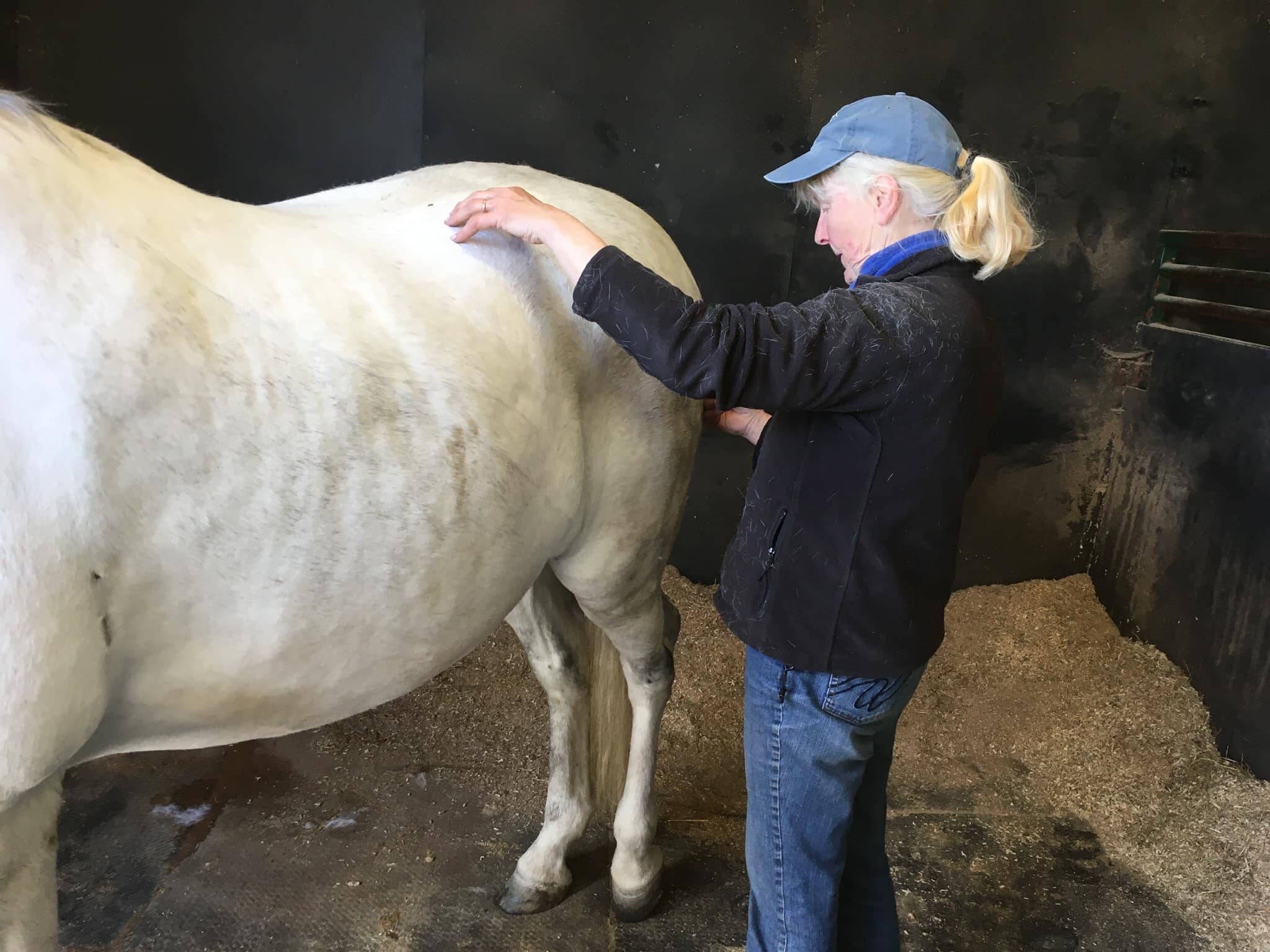
In Conclusion
The above is a very brief view of an incredibly deep and interesting part of the equine anatomy: the interconnections made by fascia.
I hope this article will reinforce the importance of trying not to ‘fix’ one problem. It’s best to work on the whole body, without getting fixated on one technique. The body is a wonderful piece of bioengineering. The Masterson Method® way of gathering information and learning to listen to the dynamics of the body, through both feel and flow, is priceless for the horse.
Additional Resources
If you’re looking for more information on fascia, there’s a wealth of free resources out there. Here are some of our favorites:
- The Equine Documentalist Videocast with Martina Neidhart – The Hoof and Its Myofascial Connections
- Webinars with Wendy No. 108 with Becky Tenges: Following the Fascial Freeways
- Equine Dissection Courses
- Sharon May-Davis
- Gillian Higgins
- Lorre Mueller, MMCP
- Ivana Ruddock-Lange
- The Horse Inside Out (online learning options)
Leigh Jackson, MMCP comes from a farming background from West Cornwall in the UK. She certified as a Masterson Method practitioner in 2012. Leigh says, “Just when I or we think we have ‘got it,’ life, the universe, and horses throw us a curve ball. I never stop learning, and love the journey!”
